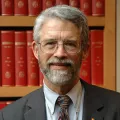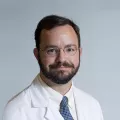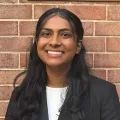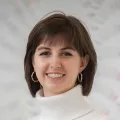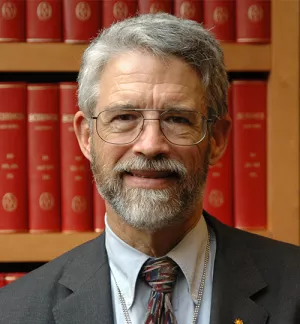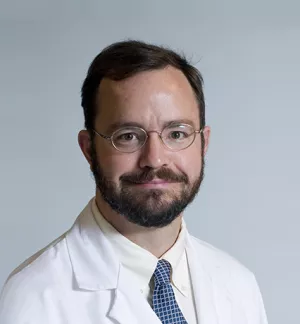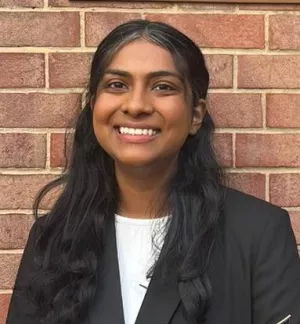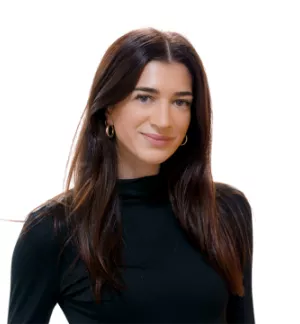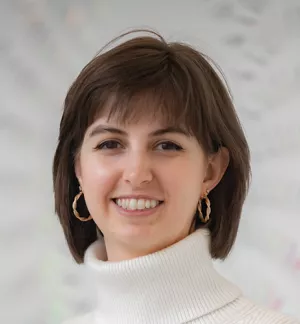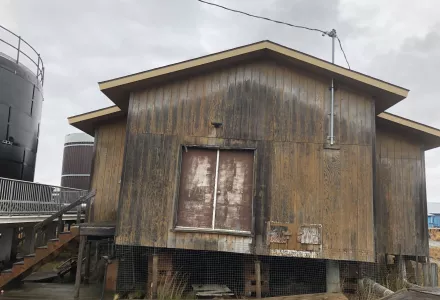
Imagine you urgently need to see your doctor, but the road from your house to the clinic in town is potholed and crumbling, and it shifts from day to day. Or perhaps the ground beneath your house is sinking, and the door frame is too crooked to fully shut out the cold and the damp.
That’s the reality for many people living in the Alaskan Arctic. “There's kids growing up in homes like that all over Alaska,” said Edward Alexander, Senior Arctic Lead at Woodwell Climate Research Center, during an April seminar on permafrost thaw and health. “In the house that can't open the window, you can't get the fresh air in. The front door might open or might not.”
Permafrost thaw in Alaska is more than an environmental or infrastructure crisis: it is a rapidly escalating public health disaster. Destabilization of essential infrastructure such as water treatment facilities, roads, and healthcare centers exposes rural and Native Alaskans to waterborne diseases and toxins, food insecurity, respiratory illness, and other mental and physical health hazards. The disruption of critical infrastructure also hampers delivery of medical services, particularly in remote areas where healthcare access is already scarce.
The Belfer Center’s Arctic Initiative hosted a discussion with environmental science and public health experts to dissect the science of permafrost thaw and its impacts on human health. The speakers included Edward Alexander, Senior Arctic Lead at Woodwell Climate Research Center and Co-Chair of Gwich’in Council International; Dr. Stuart Harris, Associate Professor of Emergency Medicine at Harvard Medical School and Founder of the Division of Space, Ecological, Arctic, and Resource-limited Medicine, and John P. Holdren, Co-Chair of the Arctic Initiative. The seminar was sponsored by the Permafrost Pathways Project, a joint initiative of Woodwell Climate Research Center and the Belfer Center’s Arctic Initiative focusing on climate science, policy, and environmental justice.
At the seminar’s conclusion, Arctic Initiative Research Assistant Aruni Ranaweera introduced a new policy brief, co-authored with Senior Program Coordinator Tessa Varvares, which offers an overview of the acute health hazards posed by permafrost thaw, as well as opportunities for policymakers to combat these challenges using government and community resources.
Watch the recording and read key points and a transcript from the discussion below.
Watch the Recording
Key Discussion Points
- The Science of Permafrost Thaw: 85% of Alaska is underlain by permafrost, a frozen mixture of soil, sand, rock, and ice. As temperatures rise, permafrost thaws and the land above the permafrost slumps and subsides, damaging infrastructure, releasing toxins and pathogens, and increasing vulnerability to erosion and wildfires. Organic carbon trapped in the permafrost decomposes and is released as carbon dioxide and methane, intensifying climate change. The magnitude of permafrost thaw’s global impact is still very uncertain but potentially large. Better monitoring and modeling is needed to inform both local adaptation measures and global mitigation strategies.
- A Local Perspective on Permafrost Thaw: Permafrost thaw is already disrupting the daily lives and hurting the health of many Alaskans, particularly Alaska Natives. While reducing greenhouse gas emissions is the only proven way to slow or stop permafrost thaw, adaptation measures are urgently needed as many communities are already experiencing impacts that require immediate infrastructure and health solutions. However, uncertainty about many permafrost thaw-related risks, such as permafrost-wildfire interactions and toxins contained in permafrost, hampers adaptation efforts at the local level. Indigenous knowledge and leadership are crucial for shaping appropriate policy responses.
- Climate Change Affects Human Health: A functioning biosphere is the foundation for human health, wealth, and stability. From an evolutionary standpoint, humans are adapted to live in a relatively narrow set of environmental conditions. Therefore, climate policy is health policy. The way most societies are organized today does not recognize the relationship between human health and ecosystem health. Failure to aggressively address climate change and environmental degradation is a poor economic decision and one that goes against our rational self-interest as a species.
Read the Transcript
-
Jennifer Spence: Good morning everyone. Thanks so much for joining us on a Thursday morning. This is a hybrid event, so we have folks in the room and then we have folks online. We've been working on this event for some time, and on this topic, which I think is incredibly important.
I want to start by emphasizing a few logistical things. This is a hybrid event. It is being recorded and we will be sharing the recording after. We will have opportunities for questions, and we hope this can be a thoughtful and engaging conversation that respects the perspectives of the different people in the room. So thanks so much to everybody for coming.
This is an initiative that is based on a project that we are part of here at the Arctic Initiative called Permafrost Pathways. It was launched in 2022 and is funded by the Ted Audacious Project. We have colleagues here from the Woodwell Climate Research Center who are the leads of that, and we, at Harvard Kennedy School's Arctic Initiative, have been part of the team since its inception. The focus of the project is looking at climate science, policy action, and environmental justice. We have, over the last several years, been looking at both adaptation and mitigation strategies for addressing permafrost thaw.
It's in this context that we come to the issue of health. When we first started looking at it, we very much were looking at the traditional relationship between science and policy and what that meant for climate action. But what became very clear through our conversations with colleagues who are in the room and are going to speak with you today is that health is an incredibly important lens to bring to this.
So, we were really excited to expand our view on what we were working on and really be part of thinking critically around the relationship between permafrost thaw and health. And as my dear colleague, Stuart Harris, will likely talk about, health is an incredibly powerful tool to tell the important stories that need to be told. I'm stealing his ideas already before he even starts.
Let me quickly run you through the flow of the event. We have three impressive speakers who are going to talk to this issue from different perspectives. They're going to make some opening remarks on each of these, and then we're going to move to a Q&A format. I'll probably ask a few questions, but ultimately you'll be invited to ask questions as well. I hope that as they are presenting, that sparks some ideas and questions and comments you would like to share. And then as a finale to this, we're excited to have our research assistant, Aruni Ranaweera, who will introduce to you a policy brief that we have prepared on this that we're launching here today and in honor of World Health Week. It will be available virtually, but we wanted to give her an opportunity to introduce the ideas in that for you as well. So that's how we will close today.
Without further ado, and - I guess I realized I just haven't introduced myself either. So sorry. I'm Jennifer Spence, I'm the Director of the Arctic Initiative and I'm also part of the Permafrost Pathways team. It really is a pleasure and honor to be here to moderate this session. We're going to start with Professor John Holdren.
John Holdren is the co-chair of the Arctic Initiative and one of the founders of the Arctic Initiative. He is the Arctic Initiative lead for the Permafrost Pathways project and has a long and prestigious history in science and policy that I couldn't possibly try to explain here, but I think most notably for those in the room was Obama's science advisor for eight years and so really has worked in that space between science and policy. John is going to give us an introduction to permafrost thaw that will lead us into the health elements. And John, if you would like to take it away.
-
John Holdren: I will try to give a quick introduction here to the science of permafrost thaw and its impacts, which I hope will lead into the subsequent presentations.
Just very quickly, the basics. A lot of the land in the Arctic and sub-Arctic is underlain by permafrost. People are sometimes shocked to learn that 85% of Alaska is underlain by permafrost. It is defined as a frozen mixture of soil, sand, rock, and ice. Much of it's been frozen for millennia. Next point, as this soil temperature rises along with the air temperature, permafrost warms and starts to thaw and land overlying the permafrost slumps and subsides. When that happens, organic carbon trapped in the permafrost is decomposed as it gets warmer and gets released as carbon dioxide and methane, both potent greenhouse gases.
We are monitoring around the Arctic. We were, until 2022, even monitoring in Siberia with the collaboration of Russian scientists. That's now obviously a much more difficult matter. But all across the Arctic, we are seeing permafrost thawing. We're seeing increased emissions of carbon dioxide and methane, but our measurements are still not pervasive enough or continuous enough to have a good handle on exactly how fast the permafrost is thawing and exactly how much carbon dioxide and methane are coming out, never mind how much will come out in the future.
Finally, pretty obviously, the future emissions are even more uncertain than the current ones. And that's in part not just because of the monitoring, but because future warming rates are uncertain by a very substantial margin. And as probably everybody in this room knows, there are scientists, a few, who still think that confining global warming to 1.5 degrees Celsius above the pre-industrial average is feasible. Most scientists are now saying it's not feasible. We'll be very lucky to stop at two. My distinguished colleague, Dan Schrag, who's not here today but is a major expert on climate, thinks we're heading for four. So that magnitude of uncertainty has a big impact, obviously, on how much is going to come out.
The other point in the uncertainty is our inadequate understanding of the details of the processes, bio-geophysical processes, that affect permafrost thaw, and the resulting emissions.
Just a quick look at the extent of terrestrial Arctic permafrost that I should add, there is also sub-sea permafrost under the continental shelves. Very little is known about what might happen there. But just looking at the land permafrost, you can see there's a lot of it. You also see that Russia has more of it than anybody else, which again means that losing access to monitoring in the Russian permafrost is particularly detrimental to increasing our understanding of the whole picture.
A quick look at the main impacts. They are local-to-regional, regional, and global. Local ones, when the land subsides, you can damage roads, buildings, walkways on tundra, sewage and water pipes, power lines, oil and gas pipelines, other energy infrastructure. It's a big deal locally in areas where the permafrost is slumping. Local-to-regional permafrost thaw can release previously frozen mercury, industrial toxic waste, bacteria. Anthrax has already happened from thawing permafrost, viruses of a variety of kinds. Regionally, permafrost thaw increases vulnerability to erosion, including coastal erosion, also increases vulnerability to wildfires. That's a vicious circle because wildfires accelerate permafrost thaw and permafrost thaw accelerates wildfires.
Globally, the carbon dioxide and methane released from thawing permafrost. They're globally mixed greenhouse gases, so they contribute to the global warming phenomenon and increase all of the impacts of that global warming phenomenon and increase the costs of adaptation, the cost of unavoidable damages, and they fuel positive feedback. More warming makes more permafrost emissions, make still more warming; a nasty, nasty picture. That puts at further risk the Paris targets for limiting the global average surface temperature to 2 degrees Celsius above pre-industrial. And as I show here at the end, the magnitude in detail is still quite uncertain, but it's potentially large emissions from thawing permafrost could take a big bite out of the remaining budget before we exceed 2 degrees Celsius.
Just visualizing permafrost thaw very quickly, you see at the top left an example of major down slope slumping and sliding top right, what's happening in communities around the Arctic where even the walkways between buildings become unstable and unusable. Coastal erosion and permafrost thaw acting together on the lower left. And then an example of what happens to roads under permafrost thaw.
A few key observations about all of this. The only currently proven way to slow permafrost thaw and the growth of its greenhouse gas emissions, it's to slow global warming itself by reducing civilizations, direct emissions of greenhouse gases on the whole.
There is a possibility, I stress possibility, that permafrost thaw rates could be reduced by local to regional actions, such as better control of wildfires or regionally focused geoengineering. But these approaches are in the early stages of research and we can't count on them. Third, some local impacts of permafrost thaw can be ameliorated by engineering, but those approaches are limited by costs and scale and sometimes retreat or relocation will be required. We need better information clearly about local-to-regional pace and distribution of permafrost thaw and its impacts just to inform adaptation measures. And we need better information about permafrost greenhouse asset emissions versus time in order to inform global strategies for both mitigation and adaptation.
Just a word about permafrost in the context of the Belfer Center's Arctic Initiative. We actually have been working on permafrost thaw from the beginning, 2017. Although obviously our work expanded when we joined the Woodwell Climate Research Center in the Permafrost Pathways project. The focuses of the initiative from the beginning have been primarily these four: governance, cooperation, and diplomacy in the Arctic, sustainable Arctic Ocean management, understanding permafrost thaw and its impacts, and resilience, adaptation, public health, and infrastructure. I note that findings about permafrost thaw are very relevant to the fourth item, that the third and fourth are very closely related.
Cross-cutting themes in the context of these focuses. Collaboration is big. Collaboration with other national and international organizations. Engaging Indigenous peoples as partners. Linking science to policy and helping to train the next generation of Arctic leaders. Those apply to all of the strategic focuses that are truly cross-cutting and all of them play major roles in our permafrost work.
So to talk about some of those collaborations, the most important one, at least arguably, is the collaboration with the Woodwell Climate Research Center. We are a founding partner in the Center's Permafrost Pathways project, funded over a six-year period by the TED Audacious Project at the princely sum of about $41 million. Sounds like a lot until you look at the cost of expanding rendering, which is high. Focus as already noted, is on improving monitoring and modeling permafrost thaw and its emissions across the Arctic to inform local to regional adaptation measures and to inform global climate strategies. And I should say that one of the speakers who will follow me, Ed Alexander, has recently joined the Woodwell Climate Research Center as senior Arctic lead and we're very happy to have him. I've been working with Ed for years and he's a huge asset, also a big guy.
Another important one, again, represented on this program is the Siamit Partnership among Harvard Med School, Manillaq Social Medicine, Mass General Brigham Hospital. Our affiliate in the Arctic Initiative, Stuart Harris, will be talking here, co-founder of Siamit, founding chief of the Mass General Hospital Wilderness Medicine Division. He's been leading work for quite a long time now to improve healthcare in Alaska native communities. And now permafrost is being incorporated into that work as you'll hear.
Another important collaboration has been with Canadians, with Canadian government, academics, and NGOs. Our director Jen Spence, from whom we heard at the beginning, has led a multi-year interaction with multiple Canadian partners to elevate permafrost thaw and its impacts on the agendas of Canadian officials. I've taken part in that myself. I think we've had a considerable positive impact.
All right, that's it from me. Thank you for your attention.
-
Spence: Wonderful. John also did some of the informal introductions to our next speaker, but I will also say my thanks to Edward Alexander, who is large in many ways but has been a large part of the Arctic community and a leader in many, many ways.
In particular, Edward is the head of delegation for SAOs at the Arctic Council for Gwich'in Council International and has performed that leadership role for an extended period of time. And in that work is both involved in the working group of the conservation of flora and fauna and the emergency preparedness prevention response working group. In particular, and I think something that led to the connection with this particular project, is Edward was the co-chair of the Council's Wildland Fire Initiative over the last two years, and we are extremely excited that he has recently joined the Permafrost Pathways team as Woodwell's Senior Arctic Lead.
So Edward, please, if you would.
Edward Alexander: [Self-introduction in Gwich'in language] I'm very pleased to be here with all of you today. I wanted to tell a little story about my average day and how it differed from my morning drive into the Belfer Center today. As I hopped in a Lyft this morning on the way over here, a number of things struck me as different about my ride. The road was smooth, the driver seemed unconcerned about the quality of the road. There were people rowing boats here. Everybody seemed to be going about their day. I looked around at the buildings, all in brick and stable and good, and it was just much different than my average day.
But then I'm from a house on the flats, in English they call it Fort Yukon, north of the Arctic Circle. But then I'm living in a town called Fairbanks in English, but in Gwich'in, we call it 'tan nan'. It's frozen earth. Basically, I live in the town of permafrost. My morning there is a little different. I wake up, I walk out to my little meadow and there's permafrost down in my meadow below my house. You can see it caved in, look down into the hole there. Sometimes you can see the bottom and sometimes not.
I'd walk up to my house and have a cup of coffee and sit with my kids for a minute, have a moment of peace. It reminded me of a couple years ago when the whole town was covered in smoke, thick smoke. I had to drive my kids to go somewhere. We started driving in and immediately the road is different than yesterday. It's not the same. The road's not the same any given day. Today, there's water impounding on the side of the road over here. There's a culvert that's sticking up out of the ground that wasn't sticking up out of the ground yesterday.
You have to kind of dodge these new potholes that are appearing. You have to maybe change lanes as you're driving and you see everybody kind of doing this maneuver down Chena Hot Springs Road on the way into Fairbanks. You get into town and you see houses that are tilted over into melting permafrost. When you think about their family, there's a kid growing up in that home. There's kids growing up in homes like that all over Alaska. The house that can't open the window. You can't get the fresh air in. The front door might open or might not.
So you think about all of these things as you go through and you start realizing how much you know and how much you don't know about what everybody in the north is going through as far as the health impacts of what's going on in their home. It might be that they can't get fresh air. It might be that their home has fallen in. It might be that their property, which they might be using to help provide food for themselves, is collapsing into the ground. It might be that they go to a place and expect it to be there, but it's not there when they get there.
So I get into town and I go to my local coffee shop on this smoky morning. Everybody's just looking to get out of it. And I see this old lady there, we share a lot in common. She's Gwich'in. She had recently visited this village in Old Crow off the Porcupine River. She comes to me and she says with concern, she says, "Do you know that one creek?" And I know which creek she's talking about because we both have the same favorite creek and it's right at the Canadian-U.S. border. It comes out pretty much about a hundred feet from the border and it's got the sweetest water.
Everybody stops there between the villages and we get our cup out and we dip it in there and the water is just so sweet. This is what she wants to talk to me about and she says, "It's not there anymore." I said, "What do you mean?" Said, "Well, permafrost melted and the whole side of the hill came down. So there's still water there, but now it's mud."
And so this is on the average day that you can go through and have all these different experiences all along the way. This tale of permafrost is that it's not what we know that's interesting about this, it's not what we know that's concerning about this, but it's what we don't know. And so we don't know where the pothole's going to be. We don't know whether your house is safe or not. We don't know if... And then you start getting further afield in these questions.
What is it I'm breathing in the smoke? It's like I'm mobilized about my day. Permafrost is mobilizing about its day too as it thaws and it's releasing mercury and arsenic up into the roots of plants. Those plants take up that mercury and arsenic. And then you look again at this cloudy hazy thing that you're breathing in and you know that PM 2.5 goes into your bloodstream, you know that plants can take up arsenic, you know that plants can take up mercury, and you know that they're burning right now. And then you ask yourself, what am I breathing? What are my children breathing? What is everybody in the town breathing? We know it causes cancer, some neurotoxins. And then it becomes also these questions like, okay, well, John posed to us these important things about carbon and permafrost thaw potentially being the elephant in the room. It's the largest storehouse of carbon anywhere on the planet so it can upset the scale of things in the rest of the planet. But people don't know that. They don't know the question.
You may have breathed in arsenic smoke from the north already and you just don't know it. You remember those Canadian fires years ago? Do we know how much arsenic was in that smoke? How much mercury was in that smoke? Do we know the rate of permafrost thaw around the globe? No, we know after a fire burns off all the insulating layer of stuff and so forth covering this permafrost, year two, year three, year four, how fast it thaws? Do we know that? No, we don't. Only 174 million hectares of land is burned in the last 20 years in the Arctic oil zone. Some will say, well, maybe it's hard to get up and be in front of a group of people and kind of admit your ignorance. It's so important.
I don't know the answer to any of those things, but I know that 10 years from now, all across Canada, permafrost is still going to be thawing from those fires and we don't know how much gases are coming out of them. We don't know the answer to any of these things. We don't know how much of that arsenic and mercury and so forth will mobilize in our plants. We don't know that rate. We don't know what's going to happen in the next round of fires. We don't know what's going to happen to the road tomorrow. We don't know what's going to happen to the houses tomorrow or our health. We see people getting cancer younger and younger and where's this intersection? You have so many more questions and answers, right? And that's why you guys are here. You're sitting essentially in the same seat that I'm sitting. You want to learn about this issue. You have questions. And I think that these questions that we have are the most profound questions of the day.
These questions may be regional, maybe at the top of the world, but they're globally important. Permafrost thaw comes abruptly. I was told by an Indian ambassador that he wanted to learn as much as he could because he was worried about the monsoon season. Permafrost thaw and the monsoon season. Permafrost thaw of ancient bacteria and ancient anthrax and things like that. You dive into these questions and every single day as I drive into Fairbanks and into permafrost, the tan nan, tan means frozen, nan is ground. And just get more questions. Get more questions.
So I'm here as a Senior Arctic Lead, not because I have answers or something like that, because maybe I have a lot of questions about things that y'all share in common. I hope to connect people with the story that you shared in common, this place that we're going in common. And that's why I'm here today. Very appreciate all of you guys listening. Thinking about the intersection of the permafrost thaw, not just in northern communities, but to how it's going to impact, how it has impacted you already, maybe in ways that you're not aware of, ways that we certainly don't have the answers on. But we need to start asking ourselves.
-
Spence: Fabulous. Thank you so much, Edward. And then last but not least, Dr. Stuart Harris. As John mentioned, he's a practicing emergency medicine doctor at Mass General Hospital. He is the founder of many, many things, and he has a long history of working in Alaska with communities. And also this is the one that I had to write down. So SPEAR, as the chief of MGH SPEAR, which is Space, Ecological, Arctic, and Resource Limited medicine. So this is a fascinating combination of things, but in this context, we're going to get down to the heart of this in the Alaska environment. And Stuart, please, if you would.
Dr. Stuart Harris: Thank you very much, Jen. Can everybody hear me? Cool. Liz, thank you very much for help with technology. Is this the second slide? So just last week, this is the seventh edition of Auerbach's Wilderness Medicine. It's kind of the Bible of wilderness medicine, 2,600 pages. And I just took over as the editor-in-chief of the eighth edition. And we are subtitling it on the cover: Resource-Limited Care in Austere Conditions. So to better understand what our wilderness medicine is and how medicine and the environment are extraordinarily overlaying and not recognized is part of what we're doing.
So as mentioned, we started MGH SPEAR, MGB SPEAR Medicine, a couple of years ago to try to better tell the story of what it is we're doing. So we have one of the world's first space medicine fellowships, which completely interdigitates with what we do on earth as far as better telling the story of recognizing health as an ecological phenomena. But you can see that the Arctic is right at the center of what we do. And so it's a great pleasure and honor to be here today.
As far as the vision of SPEAR Med and how we tie this all together, where other people see hostile environments, we see places of extraordinary opportunity. And that can be local-regional weather, it can be moral-economic, it can be intellectual in storytelling, but just where other people start getting uncomfortable is where we hit our stride and have our most fun.
And that's looking over the horizon, seeing what's coming. As an emergency physician, what happens in the next 30 seconds might make the difference between you living and dying. And then 50, a hundred years out, I get really curious. What's that mean two or three years from now, less interesting to me. It seems like that's pretty obvious. But that ability, we were in Cherskii with, at that point, Woodwell Climate Research Center, hell, 15 years ago. But that looking over the horizon and seeing what's coming is where we tend to have our most fun.
So again, we recognize health as an ecological phenomenon, which strikes some people as a little bit odd, but the idea of arbitrary intellectual silos between science and medicine is just bizarre. We have an NIH budget that, oh, this does human health, and an NSF budget, oh, this does science.
It's like the two aren't directly overlaying, it's just bizarre. And so you can see our friend from LSU up there who almost got it right a number of years ago when he advised President Clinton that it's the economy's stupid. It's the ecology stupid. It's that functioning biosphere that provides for health, that provides for wealth and stability. And the sooner we recognize that, not in a touchy-feely way, this is a basic biology and earth science that we're not structuring either federal government or our private enterprise to better recognize.
A large portion of what we do is just rational risk mitigation, helping people to make good decisions. We're nonpartisan. We're patient-centered. We believe in cost efficiency. And I think I am somewhat heartened to feel like we've gotten to the point that it's in our economic interest to do the right thing environmentally. And that if we start appropriately attributing the costs and the damages caused by our unwillingness to aggressively address climate change to date, that we're just making bad economic decisions.
And that is a powerful tool and it's a little depressing, but it's also a great liberator. Climate change is a healthcare emergency. So what happens outside the hospital has huge impact on the people showing up in my ED every day. So if it's a hot day, as Edward was talking about, if smoke blows in from the West Coast, there are measurable impacts on human health right now. And one of the few cool things about the recent pandemic was the ability to recognize very small changes in local fine particulate matter has direct human impact on heart attack, strokes, in real time. So as we've had these massive changes, and again that sense of the ability of a single small virus, which in the grand scheme of things wasn't a scary virus like the Spanish flu around the first World War. That was scary.
That was 18 to 22 year olds dropping dead, left and right. COVID was in the grand scheme of things, pretty tame. But that one virus completely upended national policies, international policies, economics, defense. And so the ability of health to better tell the story of why the science matters. I see medicine as being at the intersection of science and story. If you're any good at all as a doctor, you take discrete scientific information and you put it into an actionable narrative, something that can help that patient with where they are. And that may be a PhD from Harvard and that may be somebody who's working on the T all night long, comes in dead tired, and you need to try to give them the information that will allow them to act in their own best interest. And so climate change is very much healthcare policy.
Where do we do it? We do it in Kotz, as we refer to it, Kotzebue, up in far northwestern Alaska.
Some pretty pictures. This out on the YK Delta with the Woodwell Climate Research Center, looking at exactly those questions of how different the timing of different burns on the permafrost impacts carbon flux and other releases.
We do it at the top of Everest. And again, looking at how the environment around you, it's kind of ridiculous, but we think, oh, we can live anywhere on the world, but if we go three miles up, four miles up, we cease to be. And it's like we live at the bottom of a pool that's so shallow. All we have to do is go four miles up and we cease to exist. And it's just bizarre. But we are very much... And I'll talk later about where we are.And then it also has given me a great opportunity to learn about how the world works. Sitting down with John Holdren on the banks of a river with Max and crew, it's like holy cow. In that intersection, I came to the Belfer Center through trips like this. So we're looking at permafrost melt and you start to learn how things are done and I should get my master's in public policy for that because I learned enough.
Why Arctic Health? Again, because it just ties all these different features together. So the environment, austere conditions. Food security is something we haven't touched on but is front and center. Its impact on local social groups. But ultimately, as Edward mentioned, this has global impact. So again, just for frame of reference, there's roughly twice as much carbon tied up in the permafrost right now is as extant in the atmosphere and we're kind of losing sleep over going from 280 parts per million to about 400 and whatever it is now, 416, 420, which is a big damn change and it's having drastic effect. But you think about that change and we've got twice as much of that being increasing or released in a positive feedback mechanism, that ought to get your attention.
And then the narrative impact, just better-telling stories. We're a story-driven species. We don't become whoever we are because of the data. I'm an American because the data say, it's like, no, that's what you're raised, that's the story you were told. Religion or family or everything else, we're a narrative species. As John touched on, this is front and center because it's warming a lot faster than anywhere else. And so it's a preview of coming attractions for wherever we are. President Obama recognized that in one of his last domestic trips, went to Kotzebue for the reason that the world is shifting around us and that temperature is a vital sign.
So how do we respond to these growing healthcare risks? A bunch of different ways. So the way we have at SPEAR Med is by working closely with our colleagues in the north. So with Maniilaq, the medical center in the Northwest Arctic Borough, you can see it in red up there. It's about a New England-sized chunk of land with about 7,000 largely Inupiaq-speaking Alaska Natives there. And so working closely with them, seeing what we can learn from them, how we can take the talents and the capacities of a major academic medical center to improve care locally. Modestly learning at every damn step of the way has been great. And we're about nine years into it now and the idea is we're getting people, first off, it was old folks like myself. We're increasingly getting fellows out there. We've got a fellow now working overnight shifts in Kotzebue last night. Thank you, Dr. Leslie for forwarding the mission. We've got a host of different fellows. We've got residents out there.
We're trying to work our way down the food chain to get younger and younger people in their medical experience into the field so they can see, hey, this is a place I can have tremendous impact, have a stunningly meaningful existence, and not end up lured away by BMW or something stupid like that.
And so part of that is direct patient care. Amar and Rupali are now at Hopkins, but were some of our early residents there and this is providing direct patient care in Kotzebue and the surrounding villages.
Part of it is just existence and listening and learning from the people who've been there and thrived and survived from 5,000 to 15,000 years and learning from them, getting to know the landscape and bringing it home.
Why a doctor and infrastructure? What the hell does that have to do with anything? And for me, and from the wilderness medicine point of view, I think one of the ways I define wilderness medicine is we go to places to provide care that either have no infrastructure or have lost it. And so post-disaster after Sandy hit New York City, that was wilderness medicine. Again, that idea, if you go three or four miles up, we cease to exist. It's bizarre. But we're a bespoke product of a particular environment. So the percentage of oxygen, the amount of barometric pressure available to be in a certain very narrow temperature range, the ability of the Van Allen belts and other means of protecting us from cosmic radiation. It's like we are a bespoke product. We were made for right here, nowhere else in the totality of the universe do we have any place being and expect to do other than less well than we do here. So respecting that and becoming aware of it.
Ultimately, infrastructure is just a means of trying to expand those conditions that have already existed. So if it's walls to keep you warm, or a roof to keep you dry, or a means of getting water to and from in a safe condition, that's all infrastructure is. It's just solving that problem of getting us back to the garden we started in, in some traditions. I think it's always worth paying attention to words and where they come from. We talk about disasters and that's an ancient... The idea that a bad star, a disaster, was what is causing this where no, these are largely anticipatable human problems that we have failed to recognize, have failed to act on. And that could be in northern Japan or it can be in large areas of the north.
I think Edward touched on and Dr. Holdren touched on a number of these, but the intersection of permafrost thaw and health threats, rather than having to justify, well, this is why this is a threat to health. If you take that overview effect, if you look at the totality of the globe, which is a teeny little ball in space and you put that in perspective, everything that's happening outside of the hospital is a source of health. So it's only at the very end when you know you've not paid attention, you've not done the right thing or bad fortune has befallen you that hospitals, doctors, pharmaceuticals, all that come into play. If you want to be smart about being healthy, it's everything you do outside the hospital, it's money well spent, it's good policy. But that can certainly be the impact of buildings. If your hospital's falling into the Chukchi Sea, that tends to not make it very effective.
If you can't flush your toilet and have it go somewhere safe and not be recycled in your neighbor's drinking water, that's something to be concerned about. Access to care. Can you drive to the hospital? Can you take your boat places that you used to be able to boat or take your sled on in certain times of the year. Now people are breaking through the ice in ways that for multiple generations people are like, no, this time of the year you can be there and now suddenly you can't. So the inability to both get people to medical care and then to get them say to Anchorage or other more definitive care is being impacted. Infectious disease, I don't think we are beginning to... Yeah, anthrax is obvious, but there are whole villages that died in the Spanish flu that are being unroofed as the ground changes.
Food security, how changes in especially with subsistence cultures, the ability, whether it's marine mammals or berries, your ability to enact the ancient tradition of millennia that has succeeded in bringing your people to a stable place, stable existence in a pretty harsh environment is remarkable and it threatens the underlying culture. And as Edward's work is looking at the linguistic integrity, all of these things are interwoven in a way that ultimately it's reassuring.
Economic security and national security. I think the world is finally waking up to, holy crap, this place matters. And nothing that we didn't know, but that's part of the job of this room is to go forth and to say, hey, again, do you just want to act in your own interest? I've gotten to the point, I don't have a huge amount of faith in humanity some days, but at the end of the day, I think we are capable of acting in our own interest and helping people to recognize you're just acting in your own interest. You're not saving a polar bear, you're not doing something hugely noble. It is of course noble, but at the same time it's just a smart thing to do. And I think with that I am done.
-
Spence: All right. So I think three very different but interrelated perspectives on this. We have a bit of time. I'm going to ask the first question, but then I'm going to invite questions from the room. One of the things that strikes me is, when I think of Edward's comment around, we don't even know the questions to ask. And we've talked about the science of permafrost thaw, we've talked about the response in medicine, and what this means in the day-to-day lives of people.
But what would you say, using a health lens, what are the questions? And give me just a couple ideas of the types of questions we should be asking that we should be trying to answer now. What are some of the priority questions that we should be trying to answer now if we use health as a lens in this context? Whoever is inspired to go first.
Harris: Yeah, I'm happy to. I think Edward's lesson of epistemological modesty, it's like what we don't know is vast majority of our sense of security and certainty in what we think we know. And just as diversion, we talk about space medicine that we're developing. Roughly as many people have been in space in the totality of human existence as summited at Everest last year. It's like what we don't know is all of it. We have very, very, very fine points on a few different people and we know gross patterns. But in the same thing on earth, I think the amount we don't know is stunning. And we know enough right now to know that fundamental mechanisms that underlie our health, our wealth, our stability, our national security are being fundamentally altered. And if that doesn't just scare the crap out of you.
I don't scare easily. I sleep pretty well at night. But that sense of, we are messing with a basic architecture that undergirds all of human existence and our beauty and our storytelling, and it's like if that doesn't give you pause, I don't know what would. And I think it's become overly politicized in a way that to the fault of both sides. If you look at 40 years ago it was pretty close, and Dr. Holdren can speak to this a lot better than I can, but pretty close to a bipartisan consensus that, oh, this is real. This is something we need to be paying attention to and how we've gotten away from the ability to tell a broader story.
And I think ultimately health for me, rather than specific questions, its ability to make real. So if your child, Johnny, is showing up in my ed again with an acute asthma exacerbation because of the fine particulate matter coming in from the West Coast or coming in from Nova Scotia fires, suddenly it's like, oh, wait a second, this is my kid's health. And so it makes it real in a way that sometimes we got to tell the story a few times before we pick up on it. But I think that's the key thing. We can go into science and explicit questions be asked, but that larger sense, the drawing back in the sense of modesty of what we don't know and what we should maybe be concerned about is what...
Spence: Great. Thanks. Edward? John?
Alexander: I think probably scale is the part that we have some idea about. And then where do you go from there? So I had mentioned 174 million hectares are burning and then you have this mobilization of permafrost, but what does that mean? It's just a number. And so for Americans, I tell them, well, that's like if the entirety of California burned, but permafrost is underneath that has twice as much carbon. But now you add Oregon, Nevada, Utah, Arizona, and New Mexico, and you're still not quite to 174 million hectares, but you're in the ballpark. And so the magnitude and scale of the health problem when you have 174 million hectares burned and now you have mobilization in the permafrost thaw for the next year, the year after, of releasing and uptaking mercury, arsenic into these plants and then you have subsequent fire years or other kinds of things that mobilize that again into the atmosphere into what we're breathing.
And so in a very real way, this is the largest mobilization of toxic type of substances that humans have ever experienced. And we don't really have a solid grasp on, is this even occurring? Is it occurring in some areas more than other areas? Last year, a year before, they had the Yellowknife fires, and everybody was worried at the time about the fire reaching some of the gold-bearing fields that had heavily concentrated areas of arsenic in them. And of course, that arsenic gets taken up in the plants and so forth. And people were worried about acute arsenic exposure from wildfires.
And so to me, there's these major health questions that we need to start asking about what's actually occurring with permafrost thaw, the mobilization of different things in there. And then there's also these other kinds of permafrost, like yedoma, that have novel viruses. And so there was a French team that had done a core sample in Russia in 2019 just prior to the pandemic. They released their paper in 2020 and they had done this core sampling of this yedoma that found 14 novel viruses in one core sample.
And so a couple of new pox viruses. That's fun, right? But then they also discovered a whole new class of virus called Pandora virus. And so also happens to be the most complex virus ever discovered by humans, the most evolved, the longest DNA chain, the virus, right? And then we start asking, well, is there more yedoma? Yeah, there's a lot more of it. Maybe we should have more than one sample. Maybe we should actually take at least one sample in the North American Arctic. There's yedoma near my home village. And the local people are saying, "Can we get somebody to take a sample?" Maybe a bird flu bird comes, flies up to this area with migratory birds. What does yedoma look like when it's melting? It looks like a lake. It's like a nice spot for a duck to fly to, right?
Spence: Right. John?
Holdren: As I've been telling my students for decades now, the most important question in almost any public policy issue is, compared to what? And what we need to do is to try to get a handle on what the biggest threats to public health are associated with what's going on in the Arctic. And a lot of them have been mentioned here. Edward has emphasized how little we know. I would say that we know a lot compared to nothing, and very little compared to what we need to know, but we ought to be exploiting what we do know to try to better characterize what the largest threats are and why, in a larger sense, what's going on matters to everybody.
Altruism is a wonderful thing and to say, well, we have to take better care of the people who live in the Arctic, it's a very important principle, but it's not likely to capture the imagination of much of the world's population. But understanding how what's going on in the Arctic is in one sense, the canary in the coal mine that's telling you the kinds of things that are coming globally. It just happens that the Arctic is on the leading edge.
And secondly, what's happening in the Arctic isn't staying in the Arctic. There are all kinds of ways, including public health ways that have been mentioned here, that what's happening in the Arctic is propagating into the rest of the world. We need to get better at quantifying the biggest threats and making those numbers meaningful to the public. Again, another thing I tell my students is the numbers aren't everything, but they are something. And if we can get a better handle on some of the key numbers that characterize the biggest threats and use that information to inform policymakers and inform the public, we can start to get more action.
Spence: Thank you. We're quickly running out of time, but I want to open it up to the audience for your questions. Yes, please at the back, and if you can introduce yourself.
Audience Member: Hi, [Gwich'in for thank you] for coming out. I really appreciate it. Stuart, I actually have a connection with you. I worked with Eric Rosenberg over on the CBCs at MGH, so thank you because I know you have a lot of knowledge. Ed, this question is for you, from one Gwich'in to another, what can you offer for advice for what do we do as a people to try and share our knowledge?
Alexander: So I think that's an excellent question. Our governance systems are really robust. And so we have the tribal council, we have [Gwich'in language] First Nation, and we have Council of Athabascan Tribal governments and we also have band offices underneath them. Engaging those systems through resolutions, through policy papers, through position stances regionally, but also as a nation I think is really important. And so trying to get to a place where we have consensus as a nation of people and then advancing those solutions on international spaces like the Arctic Council, the UN, COP, other kinds of things like that. And so really connecting good policy, all of those types of things, helping to inform our governance structure and then letting those folks who are involved in all those different things do things, but also if they're not doing things, picking up our flag and help lead the way too.
And so I think that that's really important is that our government is consistent of us and so we have to go out and do that. We can't wait for the United States to address the issue. We can't wait for Canada to address the issue. I talked to Canadian military leadership a couple of years ago and I told them your greatest threat, you're investing 44 billion to Canadian military intelligence. I gave a talk with them to buy more icebreakers and ships and some helicopters and stuff like that. I said the greatest threat to security in the north is not that, it's climate change, it's wildland fires. And then, of course, shortly afterwards, 43 million acres burned. And so that's the threat to our national security. That's the threat to who we are as a generation and so we have to address it.
Audience Member: Thank you, all. My name is Alex. I'm an MPA ID student in national development. I guess following up on the question, what are the questions? I'm curious what the answers might be. That's a general question, but I guess understanding a lot of it is to do with curbing global GHG emissions, understanding it. Unfortunately, at this point, a lot of it is also to do with adaptation, but in terms of ecological approaches, geo-engineering, Indigenous ways of understanding permafrost, is there anything that is exciting? Is there anything that is anywhere close to being scalable or cost-effective, et cetera, that you are excited about or I guess optimistic maybe?
Holdren: Well, let me start it off by saying you're very right to mention adaptation. Historically, adaptation has received only a small fraction of the attention that emissions reductions mitigation have received. That's a big mistake for much of the world.
The most important question is how do we adapt to what is already happening, what is already going on? And that's certainly true in the Arctic. I think as we have delved into this issue, what we find is that there are adaptation options that can make a huge difference. And we have to get that lifted on the agendas of local decision makers, regional decision makers, state decision makers, and national decision makers to understand that adaptation is at least as important as mitigation.
In many respects, it is going to be easier to do than some of the mitigation solutions, but we've got to increase the emphasis on the adaptation side. And that's part of the work that we're doing in the Arctic initiative is working with communities including communities of Indigenous people to figure out how affordably to increase resilience against what's already happening.
Alexander: I completely agree with John. I think that part of the adaptation question, I saw one estimate with a trillion dollars in damages from permafrost thaw. You think about that as community costs. How do we plan, how do communities plan for different events in the north? I think all of those things have to play a role. But I think one of the things that we need to do is start being really forthright in policy about what we don't know and about the importance of its inclusion as a region. And so the Arctic as a region and the UNFCCC, the IPCC AR-7 that's coming up, permafrost thaw is not a part of it.
So all of this thawing, all of this release of CO2, more worrisome, methane, how much methane is being released out of these areas, and more worrisome than that is nitrous oxide, 250 times as powerful and very plentifully could be releasing into the atmosphere. Maybe. We don't know. We don't know, but we know that yedoma is quite capable of producing this and yet we're not including it in our global stock takes. We're not including our total carbon budget plan. What are we doing there?
And so before we get to a place where we talk about even mitigation, I do have some ideas on the talking side or something, I think it's important to frame that we're not actually asking these questions globally yet, as a people yet, right? We're not tackling that. We're looking at half the math problem. Maybe a quarter of the math problem, maybe 75% of the math problem in climate change is... That's too hard, so we're not going to do it. Well, that's not an acceptable answer. We need to tackle that hard question.
Holdren: If I can come back to one thing that I think is really exciting in this space is the understanding how improving our ability to limit and control wildfires across the far north can help us with the permafrost problem and with many other problems including the smoke. And this is on the cutting edge of one of the things that Woodwell was working on, Edward's involved in, Brendan Rogers, brilliant fire scientist, climate scientist at Woodwell is working on this stuff. And there's some very interesting ideas about how we could improve our strategies and tactics against wildfires in ways that help across the board.
Edward Alexander:
I completely agree with John. I think that part of the adaptation question I saw one estimated with a trillion dollars in damages from permafrost thaw. You think about that as community costs and how do we plan, how do communities plan for different events in the north? I think all of those things have to play a role. But I think one of the things that we need to do is start being really forthright in policy about what we don't know and about the importance of its inclusion as a region. And so the Arctic as a region and the UNFDCC, the IPCC AR-7 that's coming up, permafrost thaw is not a part of it.So all of this thawing, all of this release of C02, more worrisome, methane, how much methane is being released out of these areas, and more worrisome than that is nitrous oxide, 250 times as powerful and very plentifully could be releasing into the atmosphere. Maybe. We don't know. We don't know, but we know that yedoma is quite capable of producing this and yet we're not including it in our global stock takes. We're not including our total carbon budget plan. What are we doing there?
And so before we get to a place where we talk about even mitigation, I do have some ideas on talking side or something, I think it's important to frame that we're not actually asking these questions globally yet, as a people yet, right? We're not tackling that. We're looking at half the math problem. Maybe a quarter of the math problem, maybe 75% of the math problem in climate change is... That's too hard, so we're not going to do it. Well, that's not an acceptable answer. We need to tackle that hard question.
John Holdren:
If I can come back to one thing that I think is really exciting in this space is the understanding how improving our ability to limit and control wildfires across the far north can help us with the permafrost problem and with many other problems including the smoke. And this is on the cutting edge of one of the things that Woodwell was working on, Edward's involved in, Brendan Rogers, brilliant fire scientist, climate scientist at Woodwell is working on this stuff. And there's some very interesting ideas about how we could improve our strategies and tactics against wildfires in ways that help across the board.Edward Alexander:
Yeah, the big move from wildfire to mild fire.Harris: In touching on that last part, the idea of hope. In my job as an emergency physician, I keep patients alive by being a professional pessimist. Think about all the bad things that could be going on, could explain their symptoms and make sure they're not in play.
But I think if I've learned anything in a few years I've been on the planet, if it has no other ability, human DNA is a hope factory that we are an extraordinarily hopeful species for all the things that cause us angst on a daily basis. We're at a golden age in human civilization as far as our ability, our capacity, our interconnectedness, and our awareness of that. So I have really short patience with the idea that things are hopeless. That's ridiculous. If you've had kids, if you go roll around on the floor with your kids, there's hope.
-
Spence: I am sorry. I'm going to cut it off. We're short on time. I want to give a chance to Aruni to come up here and introduce the policy brief that she and Tessa Varvares who's going to stand up for a second to be acknowledged. So I will just say that they have worked on this in collaboration with our colleagues at Woodwell and associates.
So Aruni is a graduate research assistant with the Arctic Initiative and her research is focused on adaptation and resilience. She's a second year master's in public policy student here at the Harvard Kennedy School. And she comes from a background in local government and environmental justice policy. And thank you so much, Aruni, and please if you could introduce our policy brief.
Aruni Ranaweera: Good morning. Thank you everyone for being here today. And I think one common theme that we heard today was how interconnected these issues are. The public health crisis in Alaska through permafrost thaw is an infrastructure issue, it's an ecological issue, it's a policy issue. And this report tries to take one brief snapshot into all of those issues, touching specifically on four specific areas.
We go really into water policy and how water infrastructure has been impacted by permafrost thaw, exposing communities to waterborne and water washed diseases. We have a deep dive as well into some of the food insecurity challenges that were discussed today. There is some evidence that permafrost thaw can change migratory patterns, impacting access to subsistence food sources. We also talk a lot about the housing crisis that has been discussed both in how the damage to housing can expose communities to, for example, mold that has been in their homes as well as just contributing to the housing shortage in this area.
And then finally, we talk quite a bit about access to traditional healthcare infrastructure, which is hospitals and health clinics. And we're seeing some hospitals that caves are forming underneath them as permafrost is thawing, as well as the roads and airstrips that are needed to deliver critical medical supplies to these facilities have been impacted by thaw. So if you want to learn more and get some more tangible information you can take home, this report is now online. Thank you to Liz, who worked very hard to get this on there.
We have some physical copies as well. We have stories and snapshots from Alaska to get these stories into your hands as well as some data and maps. As has been mentioned many times, this came together in collaboration with our partners at Woodwell. We had a long conversation with Stuart before this all got started, as well as Edward and Professor Holdren and the Permafrost Pathways team.
So it was a big lift. Thank you for being here today and we really hope you can take some of this information and chew on it a bit more. And I think Edward said we're all here to learn. We want to learn how to make change. So part of this policy brief is to give some considerations for policymakers who want to take action on these issues. So we connect each of these challenges that were discussed today to some policy changes that are already being made by community organizations as well as policy recommendations and thoughts for the future. Take a look. I think you'll learn a lot and there are some physical copies over there. Tessa, want to add anything there?
Tessa Varvares: No, I just want to say thanks again everyone for joining us. Thanks for Aruni for all her help, to our wonderful speakers for their participation in our seminar today, and we hope you all can take a copy or scan the QR code on your way out. Thanks, everyone.
Hanlon, Elizabeth. “The Health Impacts of Permafrost Thaw in Alaska.” Belfer Center for Science and International Affairs, May 2, 2025
The Health Impacts of Permafrost Thaw in Alaska
Hanlon, Elizabeth. “The Health Impacts of Permafrost Thaw in Alaska.” Belfer Center for Science and International Affairs, May 2, 2025
Edward Alexander
Learning Modules: Community-Engaged Research
From Arctic Initiative
-
Article
Seasonal and Community Size-Related Patterns of Population Dietary Energy, Macronutrients, and Fiber Purchased in Grocery Stores across Nunavut, Canada
December 2025 (Volume 9, Issue 12) by Sappho Gilbert, Mahsa Jessri, Lindsay Turner, Timothy Fawehinmi, Amy Caughey, Shondra Stadnyk, Laurie Kaminsky, James Ford, Rafael Pérez-Escamilla, Nicola Hawley and Robert Dubrow -
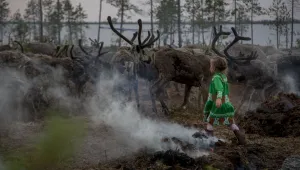 AP Photo/Petr Shelomovskiy
AP Photo/Petr Shelomovskiy

